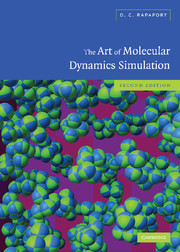Book contents
- Frontmatter
- Contents
- Preface to the first edition
- Preface to the second edition
- About the software
- 1 Introduction
- 2 Basic molecular dynamics
- 3 Simulating simple systems
- 4 Equilibrium properties of simple fluids
- 5 Dynamical properties of simple fluids
- 6 Alternative ensembles
- 7 Nonequilibrium dynamics
- 8 Rigid molecules
- 9 Flexible molecules
- 10 Geometrically constrained molecules
- 11 Internal coordinates
- 12 Many-body interactions
- 13 Long-range interactions
- 14 Step potentials
- 15 Time-dependent phenomena
- 16 Granular dynamics
- 17 Algorithms for supercomputers
- 18 More about software
- 19 The future
- Appendix
- References
- Function index
- Index
- Colophon
11 - Internal coordinates
Published online by Cambridge University Press: 28 February 2011
- Frontmatter
- Contents
- Preface to the first edition
- Preface to the second edition
- About the software
- 1 Introduction
- 2 Basic molecular dynamics
- 3 Simulating simple systems
- 4 Equilibrium properties of simple fluids
- 5 Dynamical properties of simple fluids
- 6 Alternative ensembles
- 7 Nonequilibrium dynamics
- 8 Rigid molecules
- 9 Flexible molecules
- 10 Geometrically constrained molecules
- 11 Internal coordinates
- 12 Many-body interactions
- 13 Long-range interactions
- 14 Step potentials
- 15 Time-dependent phenomena
- 16 Granular dynamics
- 17 Algorithms for supercomputers
- 18 More about software
- 19 The future
- Appendix
- References
- Function index
- Index
- Colophon
Summary
Introduction
In earlier chapters, polymer chains were represented as series of atoms coupled by customized springs (Chapter 9), or atoms coupled by rigid links whose length and angle constraints are handled by computations that supplement the timestep integration (Chapter 10). It is also possible to formulate the problem so that the only internal coordinates of the molecule are those actually corresponding to the physical degrees of freedom. Though the formalism involved, which is based on techniques used in robot dynamics, is more complex than the previous methods, the elegance of the approach and the fact that it provides an effective solution to the problem cannot be denied.
Chain coordinates
Consider a linear polymer chain of monomers. While in principle, each monomer (assumed to be a rigid object) contributes six mechanical degrees of freedom – abbreviated DOFs – to the chain, we use the argument of §10.2 to justify freezing the DOFs associated with variations in bond length and bond angle. Thus, apart from the first monomer which has six DOFs, each additional monomer contributes just a single DOF to the chain. Each such DOF corresponds to torsional motion, or twist, around the appropriate bond axis and is represented by a dihedral angle.
If each torsional DOF is regarded as a mechanical joint with a single rotational DOF that is associated with the site at one end of the link, then the system corresponds to a standard problem in the field of robotic manipulators for which techniques are available that express the dynamical equations of motion in a particularly effective manner [jai91, rod92].
- Type
- Chapter
- Information
- The Art of Molecular Dynamics Simulation , pp. 296 - 325Publisher: Cambridge University PressPrint publication year: 2004



